child restraint Mercury Mystique 2000 Owner's Manuals
[x] Cancel search | Manufacturer: MERCURY, Model Year: 2000, Model line: Mystique, Model: Mercury Mystique 2000Pages: 248, PDF Size: 2.2 MB
Page 76 of 248
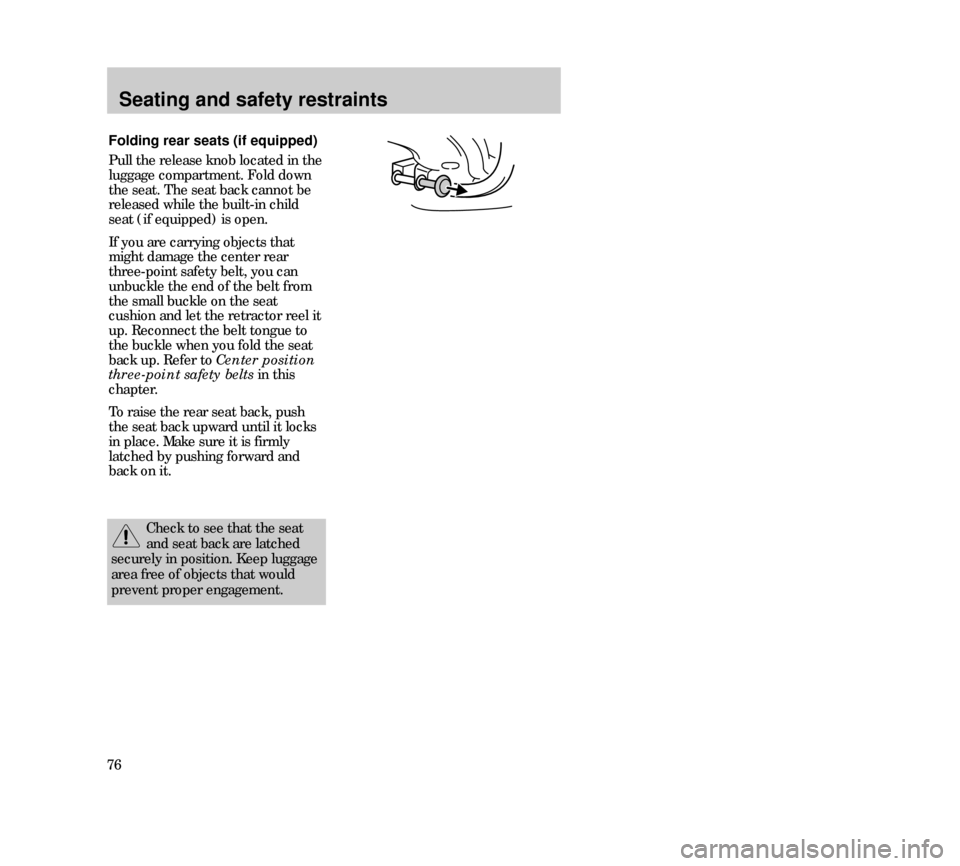
Seating and safety restraints
76
Folding rear seats (if equipped)
Pull the release knob located in the
luggage compartment. Fold down
the seat. The seat back cannot be
released while the built-in child
seat (if equipped) is open.
If you are carrying objects that
might damage the center rear
three-point safety belt, you can
unbuckle the end of the belt from
the small buckle on the seat
cushion and let the retractor reel it
up. Reconnect the belt tongue to
the buckle when you fold the seat
back up. Refer to
Center position
three-point safety beltsin this
chapter.
To raise the rear seat back, push
the seat back upward until it locks
in place. Make sure it is firmly
latched by pushing forward and
back on it.
Check to see that the seat
and seat back are latched
securely in position. Keep luggage
area free of objects that would
prevent proper engagement.
14MSSen 24.6.99 15:15 Uhr Seite 76
Page 77 of 248

Seating and safety restraints
77
Important safety restraints
precautions
The use of safety belts helps to
restrain both driver and passenger
in case of a collision. In most states
and Canada, the law requires the
use of safety belts.
Always drive and ride with
your seatback upright and
the lap belt snug and low across
the hips.
Lock the doors of your
vehicle before driving to
lessen the risk of the door coming
open in a collision.
Cargo should always be
secured to prevent it from
shifting and causing damage to the
vehicle or harm to passengers.
To prevent the risk of injury,
make sure children sit where
they can be properly restrained.
SAFETY RESTRAINTS
Front and rear seat
occupants including
pregnant women, should wear
safety belts for optimum
protection in an accident.
Always transport children
12 years old and under in
the back seat and always use
appropriate child restraints.
14MSSen 24.6.99 15:15 Uhr Seite 77
Page 79 of 248
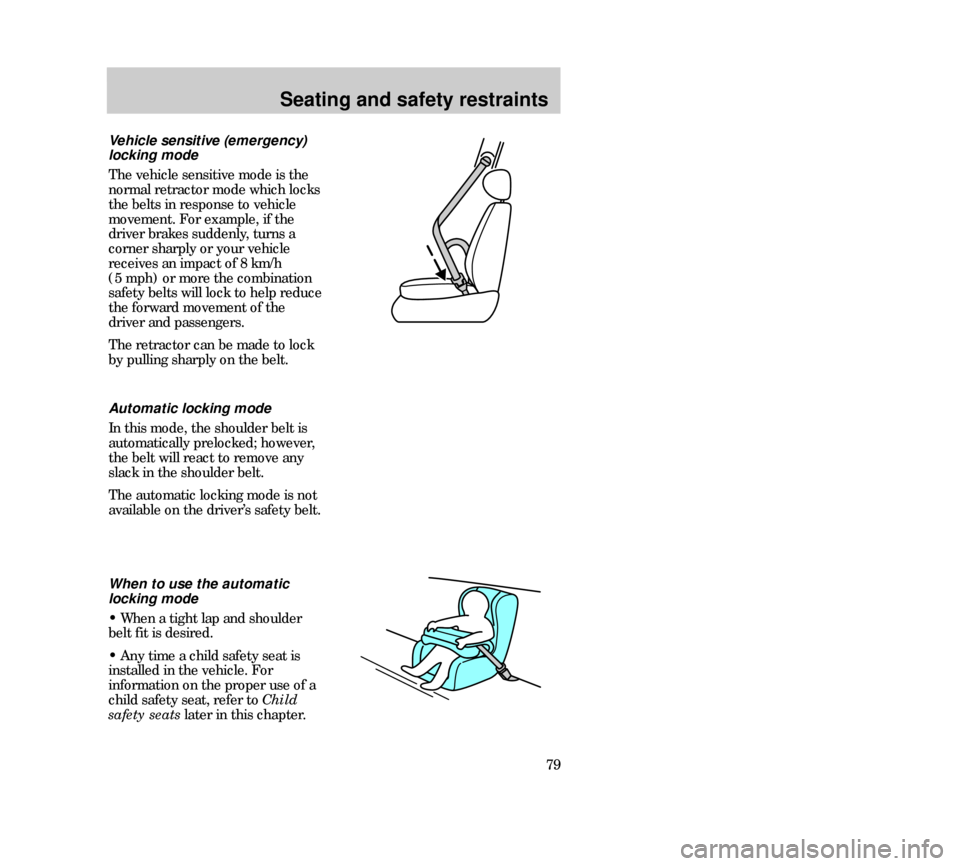
Seating and safety restraints
79 Automatic locking mode
In this mode, the shoulder belt is
automatically prelocked; however,
the belt will react to remove any
slack in the shoulder belt.
The automatic locking mode is not
available on the driver’s safety belt.
When to use the automatic
locking mode
• When a tight lap and shoulder
belt fit is desired.
• Any time a child safety seat is
installed in the vehicle. For
information on the proper use of a
child safety seat, refer to Child
safety seatslater in this chapter.
Vehicle sensitive (emergency)
locking mode
The vehicle sensitive mode is the
normal retractor mode which locks
the belts in response to vehicle
movement. For example, if the
driver brakes suddenly, turns a
corner sharply or your vehicle
receives an impact of 8 km/h
(5 mph) or more the combination
safety belts will lock to help reduce
the forward movement of the
driver and passengers.
The retractor can be made to lock
by pulling sharply on the belt.
14MSSen 24.6.99 15:15 Uhr Seite 79
Page 80 of 248

Seating and safety restraints
80Canceling automatic locking
mode
Disconnect the combination lap
and shoulder belt and allow it to
completely retract. This will cancel
the automatic locking mode and
activate the vehicle sensitive
(emergency) locking mode.
Using automatic locking mode
The automatic locking mode must
be used when installing a child
safety seat in any passenger seat.
1. Buckle the combination lap and
shoulder belt.
2. Grasp the shoulder belt portion
and pull downward until the entire
belt is extracted.
3. Allow the belt to retract. As the
belt retracts, you will hear a
clicking sound. This indicates that
the safety belt is now in the
automatic locking mode.
14MSSen 24.6.99 15:15 Uhr Seite 80
Page 87 of 248

Seating and safety restraints
87 Important supplemental
restraint system (SRS)
precautions
The supplemental restraint system
(SRS) is designed to work with the
safety belt to help protect the
driver and right front passenger
from certain upper body injuries.
AIR BAG SUPPLEMENTAL
RESTRAINT SYSTEM (SRS)
MIRRORS
OFF LO PNL/FLR
PANEL
A/CFLOOR
DEF FLR
DEF
MAX
A/C HI/
POWER AUDIO AM/FM
SCAN
SEEK 31245ANSSIDE 1-2EJECTVOLUME
000123000010 20 3040506070
80
90
10 0
110
120
13 0MPH20 406055
80120 10 0
14 0
160
18 0
200EF12
03x 1000
4
5
6
7
8BRAKE
CHECK
ENGINEO/D
OFF
CLOCK
TRACTION
TROLCH
Always transport children
12 years old and under in
the back seat and always use
appropriate child restraints.
All occupants of the vehicle
including the driver should
always properly wear their safety
belts even when air bag SRS is
provided.
NHTSA recommends a
minimum distance of at least
25 cm (ten [10] inches) between
an occupant’s chest and the air
bag module.
14MSSen 24.6.99 15:15 Uhr Seite 87
Page 88 of 248

Seating and safety restraints
88
Children and air bags
For additional important safety
information, read all information on
safety restraints in this guide.
Children should always wear safety
belts. Failure to follow these
instructions may increase the risk
of injury in a collision.
Do not attempt to service,
repair, or modify the air bag
Supplemental Restraint System
(SRS) or its fuses. See your Ford
or Lincoln-Mercury dealer.
Do not put anything on or
over the air bag module.
Placing objects on or over the air
bag inflation area may cause those
objects to be propelled by the air
bag into your face and torso
causing serious injury.
Never place your arm over
the air bag module as a
deploying air bag can result in
serious arm fractures or other
injuries.
Air bags can kill or injure a
child in a child seat.
NEVER
place a rear-facing child seat in
front of an active air bag. If you
must use a forward-facing child
seat in the front seat, move the
seat all the way back.
14MSSen 24.6.99 15:16 Uhr Seite 88
Page 93 of 248

Seating and safety restraints
93 CHILDREN AND SAFETY
RESTRAINTS
It is extremely dangerous to
ride in a cargo area, inside or
outside of a vehicle. In a collision,
people riding in these areas are
more likely to be seriously injured
or killed. Do not allow people to
ride in any area of your vehicle
that is not equipped with seats
and safety belts. Be sure everyone
in your vehicle is in a seat and
using a safety belt properly.
Safety belts and seats can
become hot in a vehicle that
has been closed up in sunny
weather; they could burn a small
child. Check seat covers and
buckles before you place a child
anywhere near them.
Do not leave children,
unreliable adults, or pets
unattended in your vehicle.
To prevent the risk of injury,
make sure children sit where
they can be properly restrained.
Whenever possible, put
children in one of the rear
seats in your vehicle. Accident
statistics indicate that children are
safer when properly restrained in
the rear seats than in the front
seats.
14MSSen 24.6.99 15:16 Uhr Seite 93
Page 94 of 248
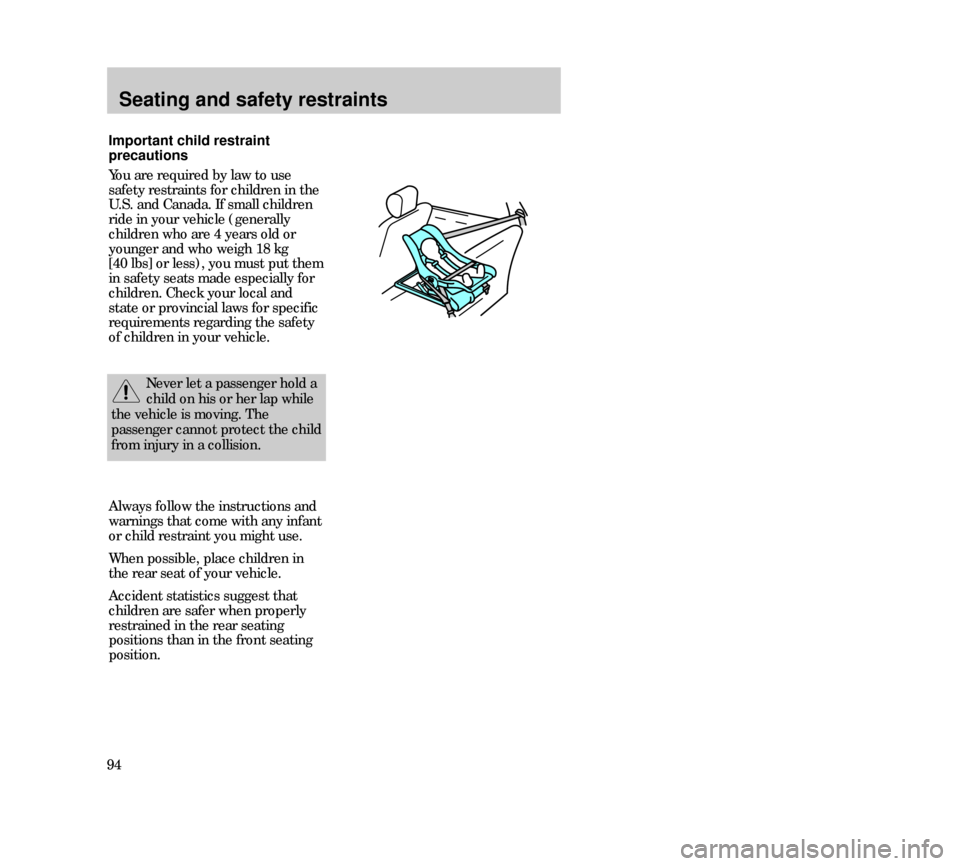
Seating and safety restraints
94Important child restraint
precautions
You are required by law to use
safety restraints for children in the
U.S. and Canada. If small children
ride in your vehicle (generally
children who are 4 years old or
younger and who weigh 18 kg
[40 lbs] or less), you must put them
in safety seats made especially for
children. Check your local and
state or provincial laws for specific
requirements regarding the safety
of children in your vehicle.
Never let a passenger hold a
child on his or her lap while
the vehicle is moving. The
passenger cannot protect the child
from injury in a collision.
Always follow the instructions and
warnings that come with any infant
or child restraint you might use.
When possible, place children in
the rear seat of your vehicle.
Accident statistics suggest that
children are safer when properly
restrained in the rear seating
positions than in the front seating
position.
14MSSen 24.6.99 15:16 Uhr Seite 94
Page 95 of 248
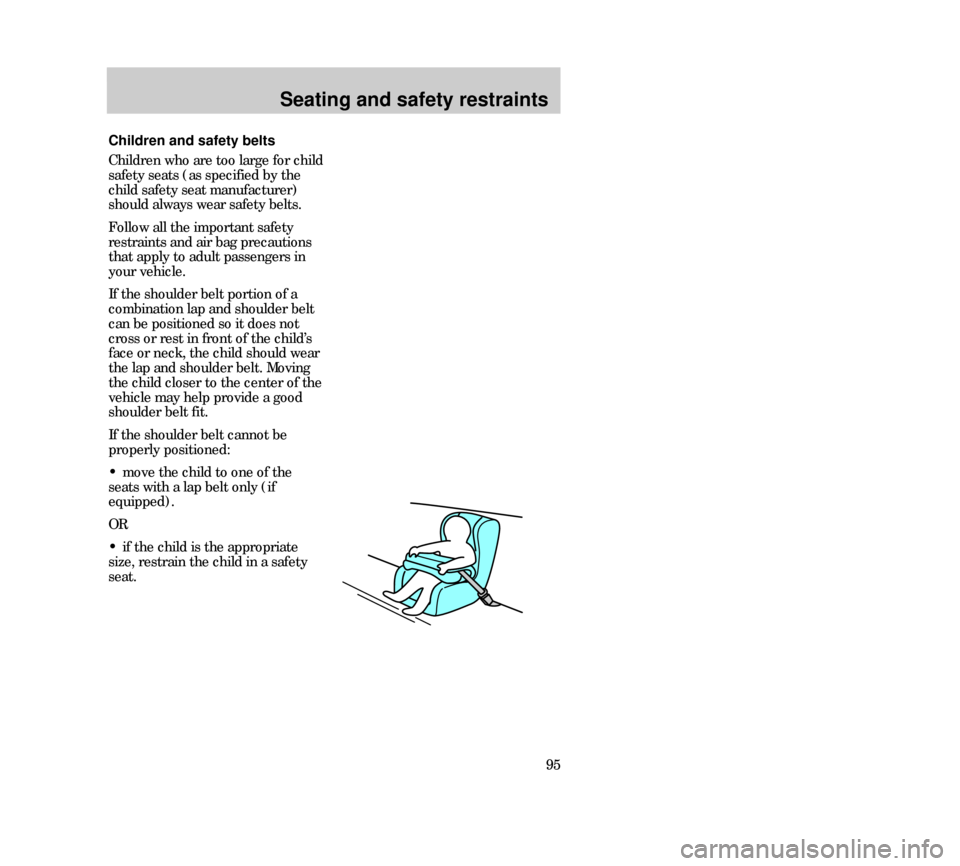
Seating and safety restraints
95 Children and safety belts
Children who are too large for child
safety seats (as specified by the
child safety seat manufacturer)
should always wear safety belts.
Follow all the important safety
restraints and air bag precautions
that apply to adult passengers in
your vehicle.
If the shoulder belt portion of a
combination lap and shoulder belt
can be positioned so it does not
cross or rest in front of the child’s
face or neck, the child should wear
the lap and shoulder belt. Moving
the child closer to the center of the
vehicle may help provide a good
shoulder belt fit.
If the shoulder belt cannot be
properly positioned:
• move the child to one of the
seats with a lap belt only (if
equipped).
OR
• if the child is the appropriate
size, restrain the child in a safety
seat.
14MSSen 24.6.99 15:16 Uhr Seite 95
Page 96 of 248
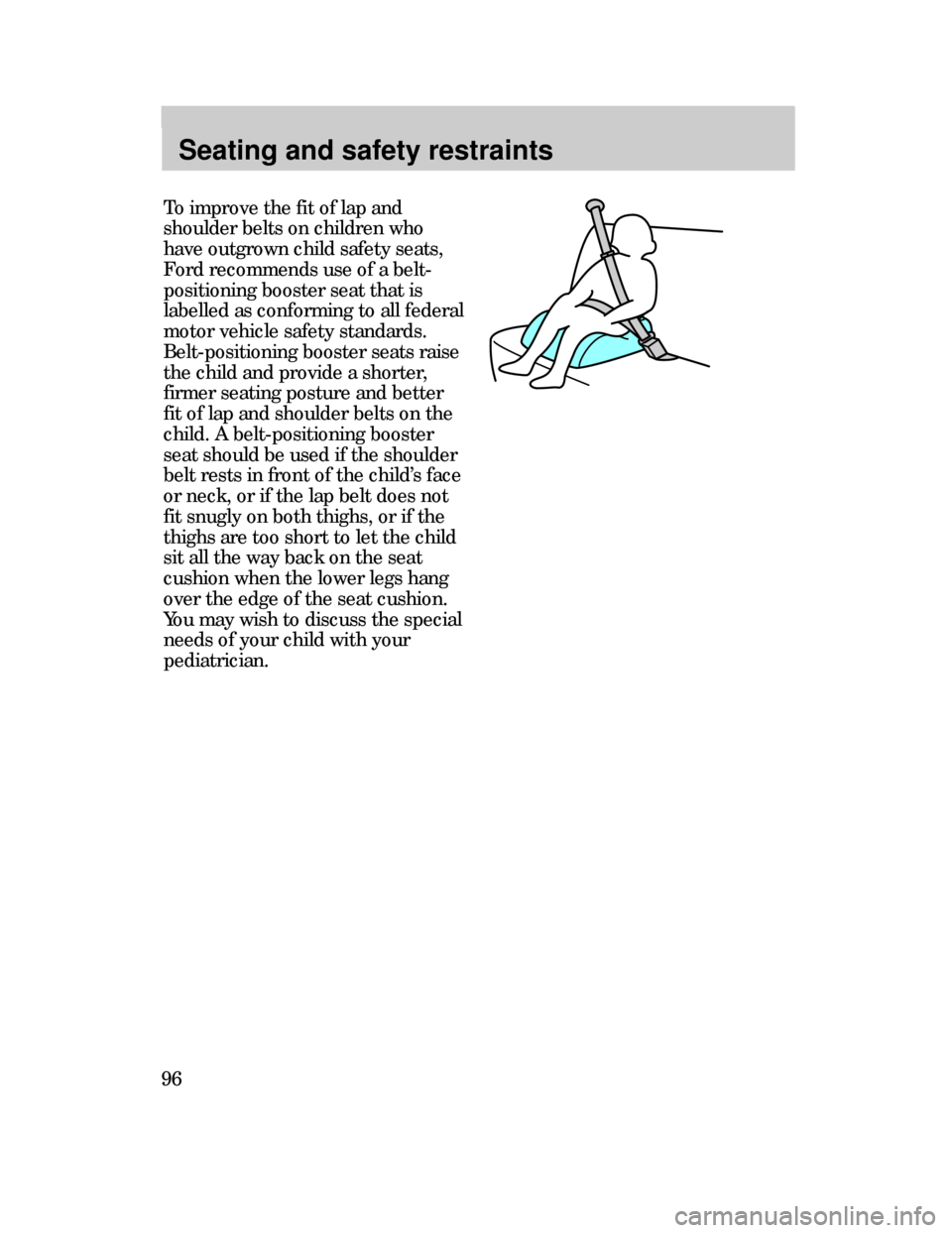
Seating and safety restraints
96
To improve the fit of lap and
shoulder belts on children who
have outgrown child safety seats,
Ford recommends use of a belt-
positioning booster seat that is
labelled as conforming to all federal
motor vehicle safety standards.
Belt-positioning booster seats raise
the child and provide a shorter,
firmer seating posture and better
fit of lap and shoulder belts on the
child. A belt-positioning booster
seat should be used if the shoulder
belt rests in front of the childÕs face
or neck, or if the lap belt does not
fit snugly on both thighs, or if the
thighs are too short to let the child
sit all the way back on the seat
cushion when the lower legs hang
over the edge of the seat cushion.
You may wish to discuss the special
needs of your child with your
pediatrician.
14MSSen 7/8/99 6:35 PM Page 96